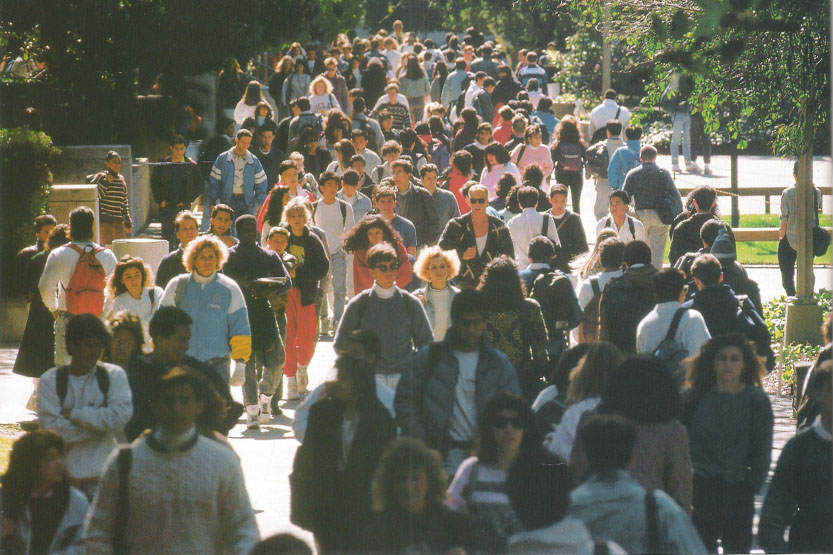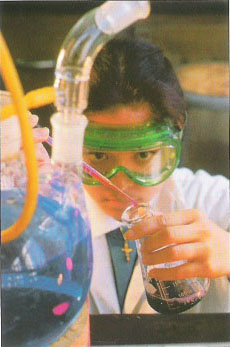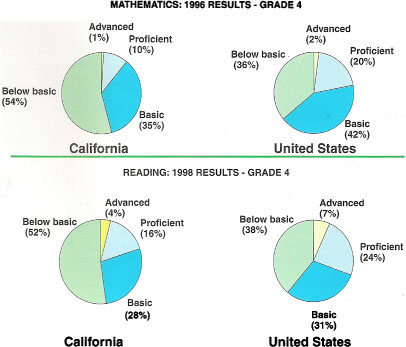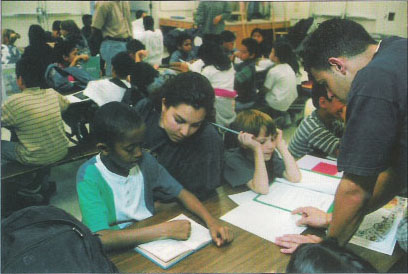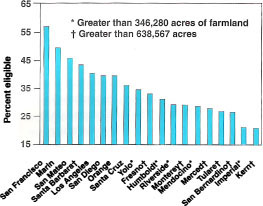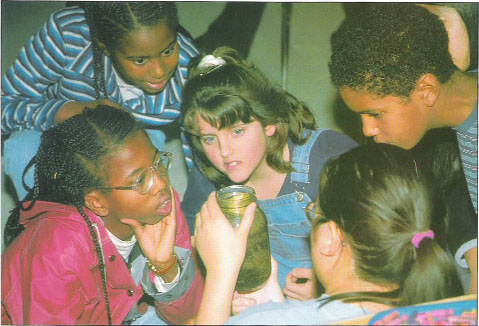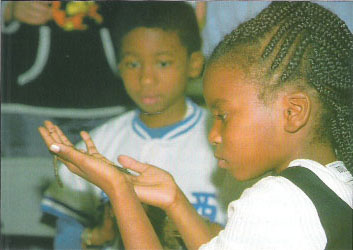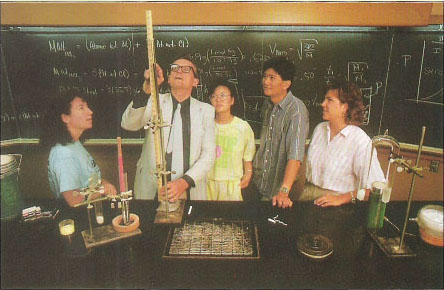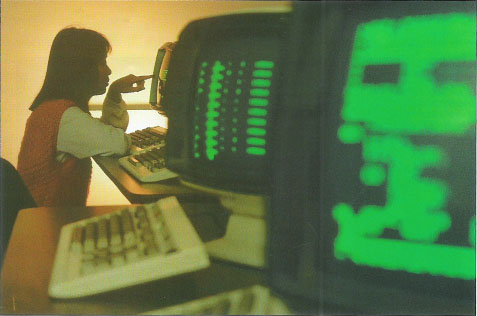All Issues
UC must take lead in curricula reform, teacher training
Publication Information
California Agriculture 54(1):56-62. https://doi.org/10.3733/ca.v054n01p56
Published January 01, 2000
PDF | Citation | Permissions
Abstract
California, once reputed to have the best public education system in the nation, finds itself ranked at or near the bottom at the end of the 20th century. Traditionally, the University of California has not been deeply involved in K-12 education, but the social and economic cost of an undereducated work-force in a global economy makes it imperative that all segments of California's system of higher education — including UC — get involved. The University can directly improve our public schools through outreach programs. At the same time, UC needs to improve its own curriculum, particularly in science and mathematics, and especially for prospective teachers. To prepare graduates for an increasingly technological world, curricula must be more interdisciplinary and inquiry-based, for science and for nonscience majors alike By breaking down traditional barriers that have prevented UC faculty from participating in curriculum reform efforts, UC can play a leadership role in providing Californians the skills and knowledge necessary to succeed in the next century.
Full text
Students from California's agricultural regions tend to score poorly on standardized tests, limiting their eligibility for institutions of higher education such as UC and California State University. Photos by Phil Schermeister.
As we enter the 21st century, UC and other components of California's system of higher education face a daunting task: to prepare a population that is changing rapidly in size, cultural background, academic preparation and geographic distribution for a world that is characterized by change and dominated as never before by science, information and technology. To provide Californians with the skills they, and the state, will need to succeed in the 21st century, it will not be enough simply to expand the capacity of California's universities to accommodate the approaching “Tidal Wave II” of high-school graduates seeking postsecondary education ( see p. 10 ). There is growing consensus that universities must also overhaul their curricula, particularly in science and mathematics, and place greater emphasis on teacher preparation. In this article, we discuss the urgent need to improve kindergarten through 12th-grade education (K-12), how reform of university science curricula will help, and what obstacles to effective reform exist within UC. We focus on education in the science, mathematics, engineering and technology disciplines (SMET) because these fields and the skills they foster are pivotal to success in the modern world.
Science/math education: What's wrong?
Spurred on by Sputnik and the Cold War, our nation invested heavily in science education and basic research in the 1950s and 1960s. The investment paid off; it is estimated that 50% of the nation's recent economic growth can be attributed to this investment, which has allowed us to dominate emerging high-tech industries (Atkinson 1999). Beginning in the 1970s, however, the nation's commitment to education waned. By the 1980s, many federal educational programs that provided fellowships for graduate students or summer programs for high-school students had been terminated.
Fig. 1. Scores of National Assessment of Educational Progress, the “Nation's Report Card” for fourth-grade students in mathematics and reading, 1996 and 1998 respectively. “Basic” level is not the desired goal, but rather represents partial mastery that is a step toward proficiency. Source: National Center for Education Statistics.
This decline in commitment to education has short-changed our students. Standardized tests administered to U.S. students now indicate that our young people are ill-prepared to participate in the technological future. The National Assessment of Educational Progress, also known as the “Nation's Report Card,” is a federally administered examination given to 4th-, 8th- and 11th-graders in the areas of mathematics, science, reading and writing. In 1992, only 7% of high-school juniors could demonstrate any ability in mathematics beyond basic algebra, while in science, only 10% of all juniors could “infer relationships and draw conclusions using detailed scientific knowledge.”
The situation has not improved in recent years. Nationwide, in 1998 only 29% of 4th-grade students showed “competency over challenging subject matter” in reading, and in 1996 only 22% showed competency in mathematics (fig. 1). The performance of U.S. students does not compare well with other countries; internationally, the United States consistently scores at or below the median of participating industrial countries in both math and science (NCES 1999a). The general conclusion is that U.S. students do poorly on tests that require complex reasoning, inference, judgment and transfer of knowledge from one type of problem to another (Elmore 1996).
While the educational performance of students nationwide is poor, the situation in California is worse. California is first in the nation in number of K-12 students, but ranks near the bottom in such performance indicators as basic skills in mathematics, reading and writing; number of students per teacher; support staffing; expenditures per pupil; scores on the Scholastic Aptitude Tests; and percentage of high-school graduates going to college. In the most recent national assessments, California's 4th-graders scored well below the national average in reading and mathematics (fig. 1) with over half of all students failing to demonstrate “partial mastery of the knowledge and skills that are fundamental for proficient work.” According to the National Center for Educational Statistics, only one state, Hawaii, was worse in reading in 1998 and only Mississippi was worse in mathematics in 1996. Within California, performance varies widely but is uniformly low in agricultural areas such as the Central and Imperial valleys. Consequently, a smaller fraction of students from these regions is eligible for admission to California's elite institutions of higher education, such as UC and California State University (CSU) (fig. 2).
ALPHA Center: UC gets involved with K-12
The ALPHA Center is an organizing structure for a variety of outreach programs. UC Riverside AmeriCorps volunteers tutor Highland Elementary School students.
The Academy of Learning through Partnerships for Higher Achievement (ALPHA Center) based at UC Riverside was established in 1999 to provide UC services and resources to public and private educational agencies including K-12 schools, community colleges, business and nonprofit organizations in the Riverside/San Bernardino area.
This unique program allows university faculty in science, mathematics and education to actively forge relationships with K-12 teachers and students. According to Executive Director Pamela Clute, in its first year the ALPHA Center worked with nearly 3,000 teachers and touched 44,000 students at 42 schools in San Bernardino and Riverside counties.
ALPHA Center's goals are to:
-
Enhance the professional development and competency of in-service and prospective K-12 teachers through interaction with post-secondary instructors and faculty.
-
Cooperate with K-12 programs to expose students to UC early enough that they are aware of higher education and resultant career opportunities.
-
Increase the competitive UC-eligibility of local area students.
-
Inform the evolution of sound educational policy by facilitating educational research on curriculum development.
-
Catalyze involvement of UC Riverside and schools in the Riverside/San Bernardino area in the national educational community.
-
Enhance the preparation of students entering UC Riverside and other institutions of higher learning. For more information, go to www.alphacenter.ucr.edu
The assessments indicate that our students are deficient in knowledge and skills that are critical for their ability to obtain jobs that provide a living wage, to exercise fully their rights and responsibility as citizens, and to contribute to the economic competitiveness of California and the United States in the global marketplace.
What skills and knowledge are necessary for the 21st century? A growing proportion of today's jobs demand that people be able to learn, to think creatively and quantitatively, to reason, to communicate, to make decisions, to solve multifaceted problems and to work effectively in groups. Today's citizens must also be broadly knowledgeable about the natural and human world around them in order to make reasonable decisions in their personal lives and to engage intelligently in public discourse about important environmental, social and health-related issues facing society. Because science and technology are central to many of these important issues, and because many of the skills listed above figure prominently in the scientific endeavor, the poor performance of U.S. students in science and mathematics is of particular concern.
Poor student performance
Many factors constrain student achievement, including large class size, lack of access to educational materials, too little time devoted to reading and other literacy-building activities, poverty, poor nutrition, dysfunctional families, drug use, violence and teenage pregnancy (Hampel 1998). While the schools by themselves cannot solve sociological problems, there is clear evidence, in the form of programs that succeed against all odds, that they can be overcome to a significant degree by an effective educational system. Those exceptions to the rule point to two additional important factors in educational quality: curriculum and teacher preparation.
Curriculum.
Nobody disputes the adage that “practice makes perfect.” The knowledge and skills that are deemed important in the modern world can be acquired by students if the classroom provides them appropriate learning opportunities. The curriculum defines what those opportunities are. Traditional curricula fall short in a number of respects. They are organized along strict disciplinary lines and emphasize facts rather than concepts, individual rather than group effort, knowledge recall rather than knowledge synthesis and application to new problems. In addition, traditional curricula offer students little opportunity to discover knowledge for themselves by engaging in hands-on inquiry, even though there is ample evidence that personal experience is a powerful catalyst to learning.
Fig. 2. Proportion of high-school graduates in California public schools meeting UC or CSU entrance requirements, by county, 1997-98. In general, counties with large agricultural areas produce fewer UC/CSU-eligible students than other counties. Sources: California Department of Education and U.S. Census Bureau.
As a first step in rectifying curricular problems, groups of university scholars and educators have been working together for decades to establish literacy goals and educational standards. Recent examples include the National Science Education Standards (NRC 1995) and the California Content Standards for Grades K-12 in Mathematics and Science (California State Board of Education 1999). A notable feature of these documents is that they include standards for skills — what students should be able to do, as well as for factual knowledge — what students should know. Curricula that teach to the new standards will emphasize quite different things from traditional curricula.
Teacher preparation.
Another major contributor to poor student performance is inadequate teacher preparation. Educational research over the last two decades gives convincing evidence that the single most powerful factor in student achievement is the quality of the teacher (ACE 1999). Yet all too many teachers nationwide lack bachelor's or advanced degrees in the subjects they teach. In 1998, only 38% of full-time teachers majored in an academic field in college rather than in subject-area or general education, and almost 20% of teachers in grades 7 through 12 reported that they did not have a post-secondary major or minor in their primary teaching assignment (NCES 1999b).
Furthermore, the most talented college students tend not to become teachers. Students who become secondary-school teachers have academic records comparable to other undergraduates; however, students who become teachers of younger students generally have below-average records (ACE 1999). Consequently many teachers are unprepared to teach technical aspects of their disciplines, much less to lead students through inquiry-based curricula that demand of the instructor a deep understanding of how new knowledge in a subject is obtained as well as sophisticated pedagogical skills.
The publication in 1983 of “A Nation at Risk” (National Commission on Excellence in Education 1983) stimulated extensive discussion about how to reverse what the report called the “rising tide of mediocrity” in K-12 education. Now, after almost two decades of analysis, there is broad consensus about what needs to be done: (1) Develop effective curricula that deliver the new educational standards; (2) Disseminate curricular materials;
(3) Attract the brightest and the best to be teachers; and (4) Train teachers well.
Students in a Sacramento after-school program are improving science literacy through the Youth Experiences in Sciences (YES) curriculum, developed by the UCCE 4-H Youth Development Program.
Curriculum development is well under way, thanks to grassroots efforts by an army of professionals interested in education and renewed investment by the National Science Foundation in science education. The next steps are more problematic because they require societal changes. The new curricula cannot be disseminated until local school districts adopt the new standards and make a commitment to implement them. The U.S. tradition of local control over education makes this large task all the more difficult. Attracting talented students to teaching careers will require a sea change in how our society views teachers. Few students who major in science and mathematics aspire to become teachers, and those who do become teachers often settle on teaching late in their undergraduate program when their academic performance precludes other, more lucrative, professions. The final step — improving teacher training — requires major change in the undergraduate programs of colleges and universities.
It is in these last two areas that universities, including research universities such as UC, can and should play a significant role in reforming K-12 education. An American Council on Education (1999) report on teacher preparation places the blame for inadequate teacher preparation squarely on the shoulders of the nation's colleges and universities and presents a 10-point action agenda for university presidents. The report calls the fact that half of the nation's schoolchildren are taught by unqualified math and science teachers a “reprehensible form of public-sanctioned malpractice.”
What is UC's role?
A common misperception is that undergraduate education is a minor component of the mission of research universities such as UC. Under California's Master Plan for Higher Education, however, UC's educational role is clearly articulated: to provide the top 12.5% of high-school graduates — the next generation of leaders and problem-solvers — with the best-quality undergraduate education. Historically, UC has interpreted “best quality” to mean providing rigorous preparation for further training in graduate or professional schools, rather than training that qualifies students to practice a profession immediately after they graduate. Such vocational training is provided by other components of California's system of higher education. UC's undergraduate curriculum therefore emphasizes development of general cognitive skills, depth of knowledge in a field of inquiry, and intellectual and problem-solving skills for lifelong learning. Inquiry, in the form of undergraduate research supervised by research-active professors is, quite naturally, a significant component of the curriculum.
Although UC has eschewed vocational training for the most part, engineering and nursing are notable exceptions. Given the urgent need for improved teacher preparation, teaching may well become a third vocation deemed worthy of the UC system. Teacher preparation has historically been the mission of CSU, which currently produces 62% of California's teachers. UC, in contrast, produces only 4% of California's teachers and has specialized in teacher training primarily at the graduate level and in the postbaccalaureate credentialing process. Teacher training is compatible with UC's mission, however, if we view teacher preparation as equally important to that of students in other professions. An appropriate role for an elite institution like UC would be to set the standard for the state by producing the very best teachers.
There are signs that UC is prepared to accept more responsibility for K-12 education and teacher preparation (Atkinson 1998):
-
UC President Richard Atkinson has committed to more than double the number of teachers produced annually by UC from 1,100 to 2,500, in the next few years.
-
The Pathways initiative provides high-school advisors and students with Internet-accessible information about UC entrance requirements in order to improve access for groups currently underrepresented at UC.
-
The UC Nexus program establishes a statewide partnership with K-12 schools, with the goal of facilitating greater use of new instructional technology, training and supporting teachers in the use of that technology, and developing improved curriculum that incorporates the new technology.
-
The Master of Advanced Study initiative will expand University Extension to offer professional and liberal arts education beyond the bachelor's degree for working adults, a program of obvious potential for continuing education of in-service teachers.
-
Finally, UC has inaugurated a new Principal Leadership Institute to train principals to lead inner-city schools.
Meritorious as these initiatives are, they do not address an important issue: the nature of the undergraduate curriculum for prospective teachers. High-quality teachers do not arise spontaneously; they are produced by programs that provide rigorous disciplinary and pedagogical training. To teach the new, inquiry-based K-12 content, teachers must be exposed to inquiry-based courses as well as the traditional courses on educational theory and practice. Here, one would think that an elite research university like UC would excel. Does it?
The need for curriculum reform
In fact, UC curricula suffer from many of the same problems that beset K-12 curricula, and there is no guarantee that graduating seniors achieve the literacy levels, particularly in science and mathematics, that are set for high-school graduates by the new standards (NSF 1996). UC therefore needs to reform its own curricula. Changes are necessary both in the “nonmajors” (general education) curriculum that provides all students with a broad understanding of the modern world, and in the “majors” curriculum that provides depth for students specializing in the SMET disciplines.
A four- to five-course “breadth” requirement is the only exposure to science and technology that nonscience majors obtain. (Conversely, SMET majors are required to take three English composition, four humanities and four social studies courses.) In California, this includes the vast majority of prospective K-12 teachers. The courses that these students can choose to fulfill the breadth requirements generally are developed independently by separate departments and are rarely integrated across departments. Hence, they are less likely to foster interdisciplinary perspectives. Furthermore, the student's major program, not the department offering the courses, determines which courses satisfy breadth requirements, so there is no guarantee that students will choose rigorous courses that provide comprehensive exposure to any particular content. In addition, few of these courses include a laboratory. At UC Riverside, for example, only seven of 28 science courses intended primarily for nonmajors include a laboratory. This means that few students have the opportunity to learn what science is by engaging in inquiry. If UC graduates, including prospective teachers, are to obtain the skills needed for the 21st century, the nonmajors curriculum must be overhauled so that it fosters language and communication skills, quantitative reasoning, application of knowledge from diverse fields to complex problems, and a core of factual knowledge about science and technology essential in the modern world.
The curriculum for students specializing in the SMET disciplines needs similar reform. In recent years, the trend has been away from laboratory or fieldwork toward strictly lecture-based courses, even for advanced students. This must change. In addition, courses for majors need to become more interdisciplinary, more conceptual and more problem-oriented if we are to prepare students adequately for any career — teaching or otherwise — in the 21st century. Internship programs are needed to expose students to real-world problems, as well as new interdisciplinary majors in areas that provide students a perspective that crosses boundaries not only between physical and biological sciences, but also between humanities and social and natural sciences. Agriculture, conservation, environmental studies and human biology are examples of subjects that are intrinsically interdisciplinary. Finally, the difficult problem of remedial education for incoming students who are deficient in basic reading, writing and mathematics skills needs to be solved.
Obstacles to curriculum reform
Obstacles to implementing curriculum reform at UC include a faculty reward system that values scholarly achievement over teaching and service, and a compartmentalized structure for curriculum administration. At an elite research university like UC, faculty “quality” is assessed primarily by published research output and success in attracting extramural grant funding. To be sure, teaching as well as professional, university and public service are also evaluated, but all faculty recognize that they will not be promoted on the basis of outstanding teaching or service if research is weak. This means that faculty cannot be expected to put in the time and effort required for curriculum reform unless they are released from other duties.
Recommendations for UC curriculum reform
UC committees are developing curriculum-reform proposals for undergraduate math and science education.
In November 1997, the Nonmajors Curriculum Committee of UC Riverside's College of Natural and Agricultural Sciences proposed sweeping curriculum reforms.
General recommendations:
Specific recommendations:
Nonscience majors will need core knowledge about science and technology to succeed in the modern world.
At UC, academic programs are the responsibility of the faculty. Most programs are administered, and faculty teaching is assigned, by departments that are organized along disciplinary lines. Most new courses originate with individual departments, and new administrative structures must be established de novo for interdisciplinary programs. Teacher preparation programs would optimally integrate efforts of faculty from science and liberal arts departments, as well from schools of education. Such cross-college programs are rare and take enormous effort to develop. It is unreasonable to think that they will happen solely through a grassroots effort by individual faculty.
Future in focus: Overcoming obstacles
These obstacles to reform of undergraduate curricula at UC can be over-come, but only if there is strong leadership from the administration and commitment of new resources to undergraduate education. Substantive resources are needed to provide sufficient laboratory space and staff support for inquiry-based curricula, and to provide incentives to faculty to participate in the cross-department or cross-college dialogue and effort needed to reform curricula and develop truly interdisciplinary programs.
There are encouraging signs that UC as an institution is accepting increased responsibility for the preparation of K-12 teachers. A Task Force Report on Faculty Rewards emphasized the importance of recognizing “the scholarship of integration, application and teaching” as well as “the scholarship of discovery” (UCOP 1991). UC President Atkinson has emphasized that teacher preparation and undergraduate education are important missions of UC and is actively encouraging campuses to take individual initiative in this area (Atkinson 1998; UCOP 1997). As a result, outreach programs such as the ALPHA Center at UC Riverside ( see p. 58 ) and two new Principal Leadership Institutes are springing up, and faculty task forces on individual campuses are evaluating curricula and drawing up recommendations for change ( see p. 61 ).
Despite these positive developments, enormous institutional inertia must be overcome for UC to achieve its potential in K-12 teacher preparation, and it is not clear that the resources needed to do so will be forthcoming. Will UC's response to the challenge of reforming undergraduate education be too little, too late for the incoming tide of young Californians?



